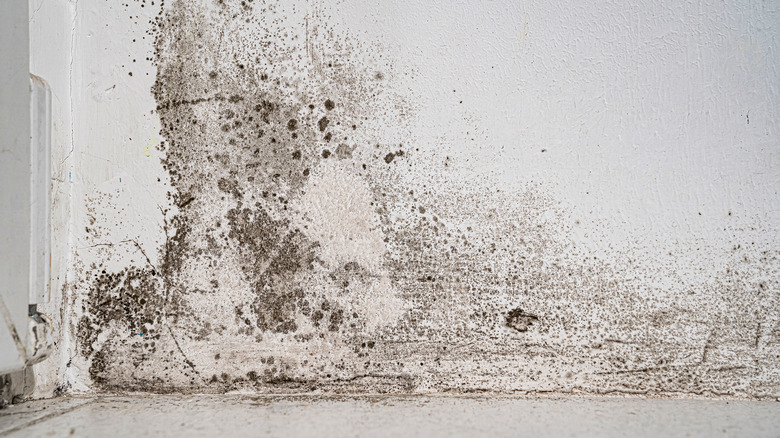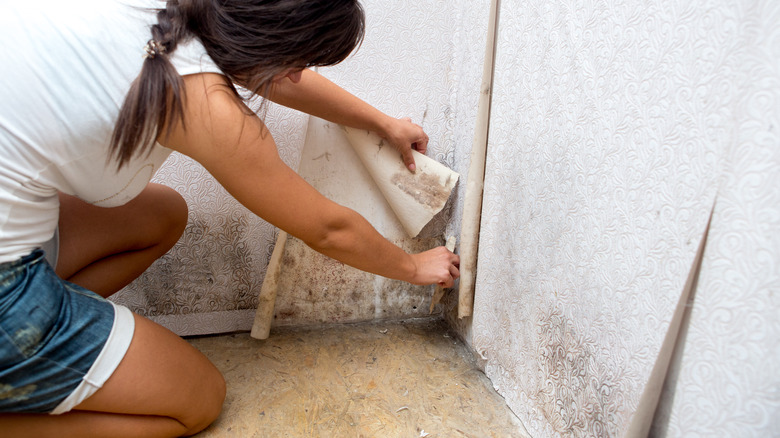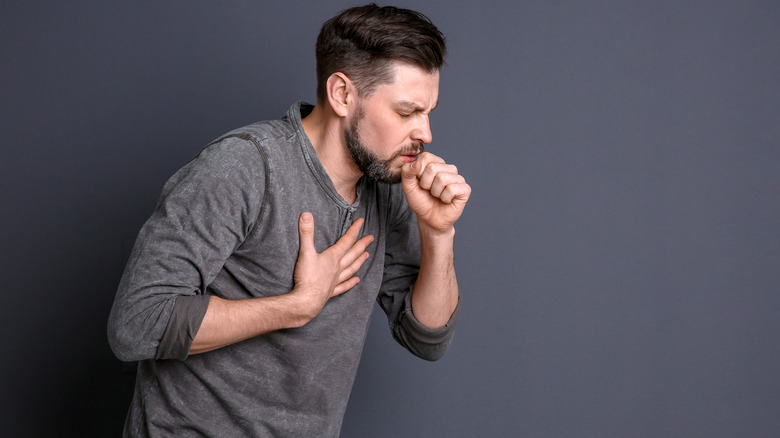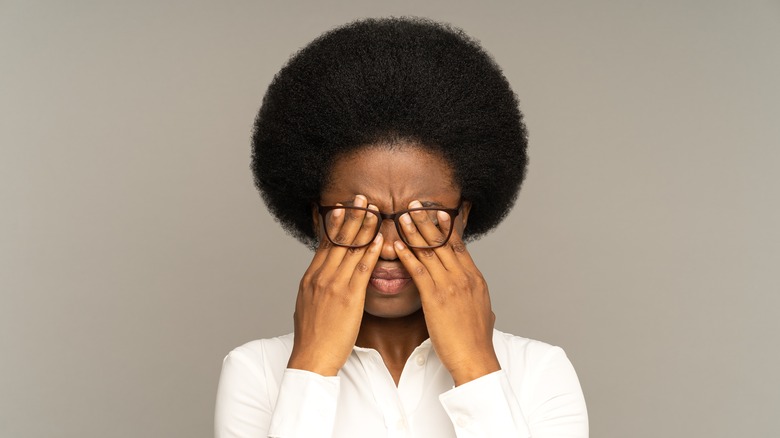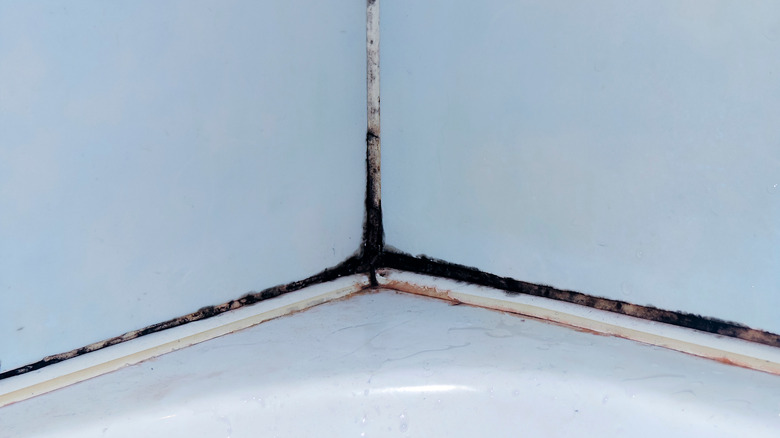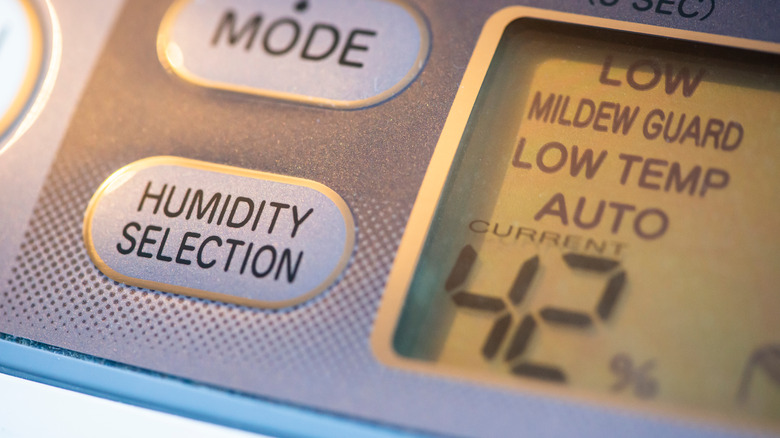What Is Black Mold And How Dangerous Is It?
Like other molds, black mold is a fungus, and it thrives in moist environments, per Healthline. There are several species of it, ranging in color from black to green. The type of black mold people are referring to when they speak of black mold is most likely Stachybotrys chartarum, according to Medical News Today.
Stachybotrys chartarum tends to grow on matter with a high cellulose content that has been exposed to moisture for quite some time, as noted by the American Society of Microbiology. For this reason, you may see black mold growing on walls and wood in places that are damp. Most likely, you will find it in bathrooms, kitchens, along window sills, or even in air ducts. It begins growing on the inside of walls first, so you may smell it before you see it. Bob Vila notes that some sealants and grout make a perfect area for growing black mold.
Black mold releases mycotoxins
Black mold is considered more toxic than other molds because it releases mycotoxins, which can be toxic to individuals who are sensitive to them. It is worth noting that all molds — not just black mold — are capable of releasing mycotoxins (via Healthline). The World Health Organization (WHO) points out that moldy foods can also produce mycotoxins. Common items that are prone to developing mycotoxins are nuts, dried fruits, apples, coffee beans, and spices.
Concern about the dangers linked to black mold arose in 1993 and 1994, when 10 babies developed acute idiopathic pulmonary hemorrhage, a condition that caused their lungs to bleed. This led people to believe that black mold was extremely toxic and could even kill people. Research conducted by the Centers for Disease Control and Prevention (CDC) determined that the homes in which the babies lived had high levels of mold caused by water damage, but scientists could not prove that the mycotoxins caused the illnesses.
Mycotoxins can be a serious health concern for some individuals
Hundreds of mycotoxins have been identified, according to the WHO. While some claim that black mold can cause respiratory diseases or cancer, there is little evidence to support this assertion. In fact, there is no scientific evidence that exposure to black mold causes more damage than exposure to any other kind of mold, according to Medical News Today. Interestingly, some people may not show any symptoms after they have been exposed to black mold.
That being said, some people are more sensitive to mold spores and could develop respiratory problems if they inhale a small amount of them. Furthermore, just about anyone can develop respiratory issues after inhaling a large number of mold spores, regardless of what kind of mold it is. Exposure to black mold probably won't kill you, but a segment of the population that could become very sick from exposure to it, per Healthline.
Symptoms of exposure to black mold
Exposure to black mold is more dangerous to individuals who are very young or old or if their immune system is compromised. People who have lung disease or a known allergy to mold are also more susceptible to health problems caused by exposure to black mold. Symptoms include coughing, dry skin, sneezing, itchy eyes and throat, and difficulty breathing, per Healthline. You may also experience headaches, memory loss, nosebleeds, and mood changes. Those who have severe mold allergies may complain of shortness of breath (via Medical News Today).
If you experience any of these symptoms and know that you have been exposed to black mold, discuss it with your doctor. They may listen to your lungs, check your blood, or perform an allergy test to determine if you have been exposed to black mold. Common treatments include antihistamines, corticosteroids, or decongestants. Sometimes, a mucus-blocking medication is prescribed, but only if other treatments do not appear to be working, according to Healthline.
How to identify black mold
Medications are only part of the treatment for exposure to black mold. If it affecting your health, removing it is of utmost importance. Black mold, as the name implies, is primarily black. However, it can also have a grayish or green tint to it. Bob Vila states that black mold is easily confused with dirt and even dust. It has small spores and is likely to be in a secluded area. That being said, if the area is moist, it will spread. Black mold has a strong smell, and well-established black mold will have an earthy odor that smells like rotting leaves. One telltale sign of black mold is that it is slimy whereas other mold are more fuzzy. You can use a test kit to help you identify the mold or have a sample sent to a lab.
You should take precautions when identifying mold. Wear protective clothing that includes a mask, gloves, and safety goggles. If you use any tools to scrape mold, be sure to clean them. If you see large areas of mold, it might be best to call a professional to remove it.
How to reduce risk of exposure to black mold in your home
Keeping the humidity level in your home below 50% is one of the most effective ways to reduce the likelihood of black mold growing in your home. If you live in a humid area, a dehumidifier is an easy way to control it. Use exhaust fans in the kitchen and bathroom to keep fresh air flowing in those areas.
You can also use a filter on your air conditioner that removes mold spores from the air. Clean your bathrooms and kitchen frequently, and wipe away any mold or mildew as soon as you see it. If any materials receive water damage from flooding or leaking, you should dry them out or get rid of damaged materials that cannot be salvaged (via Medical News Today). If you have a basement, check it regularly for leaks. In addition, make sure your basement and any crawl spaces are well ventilated, per Web MD.
